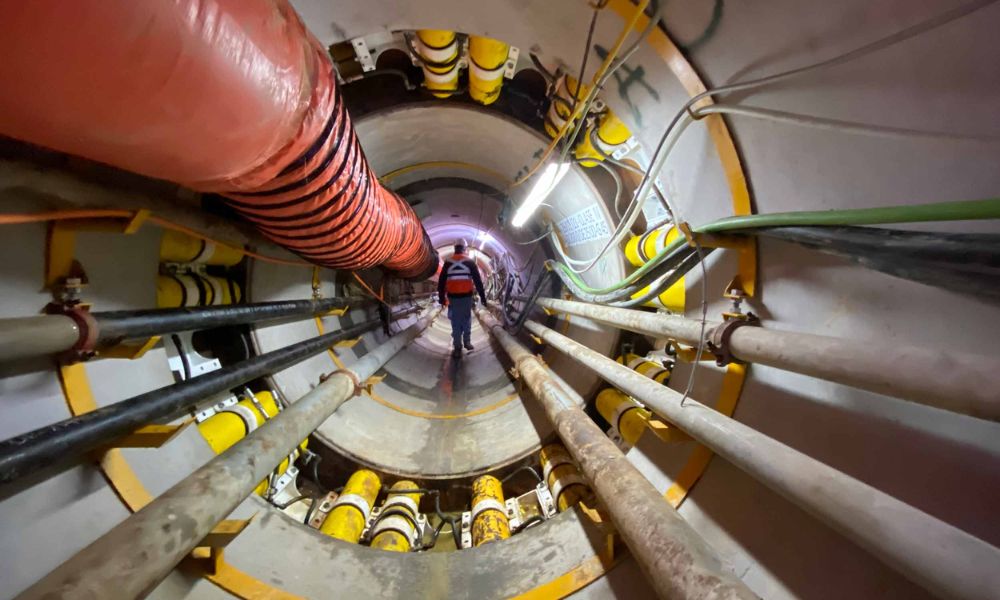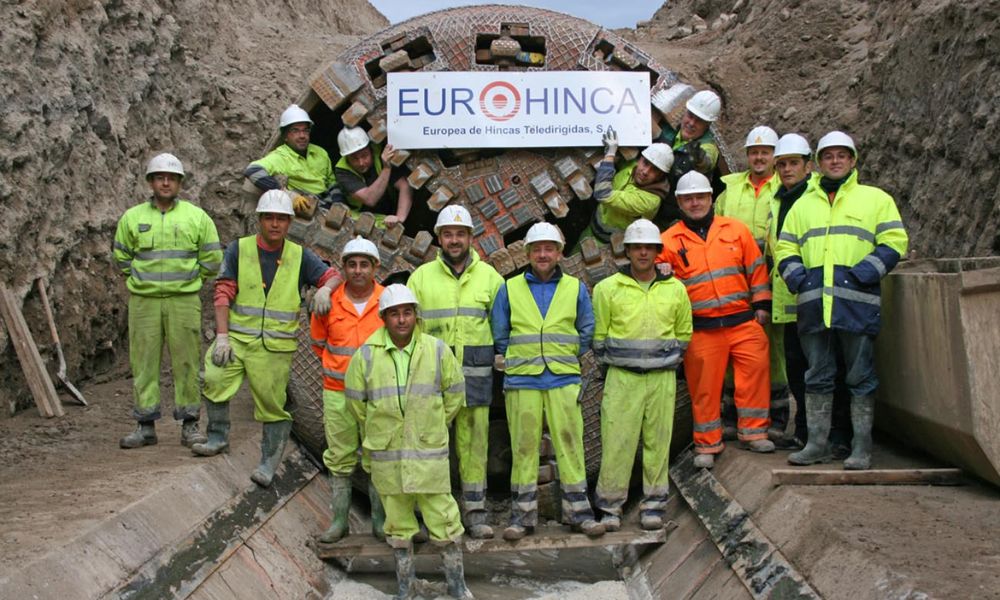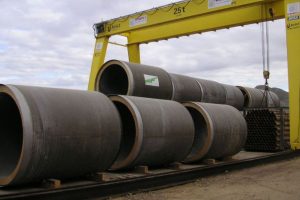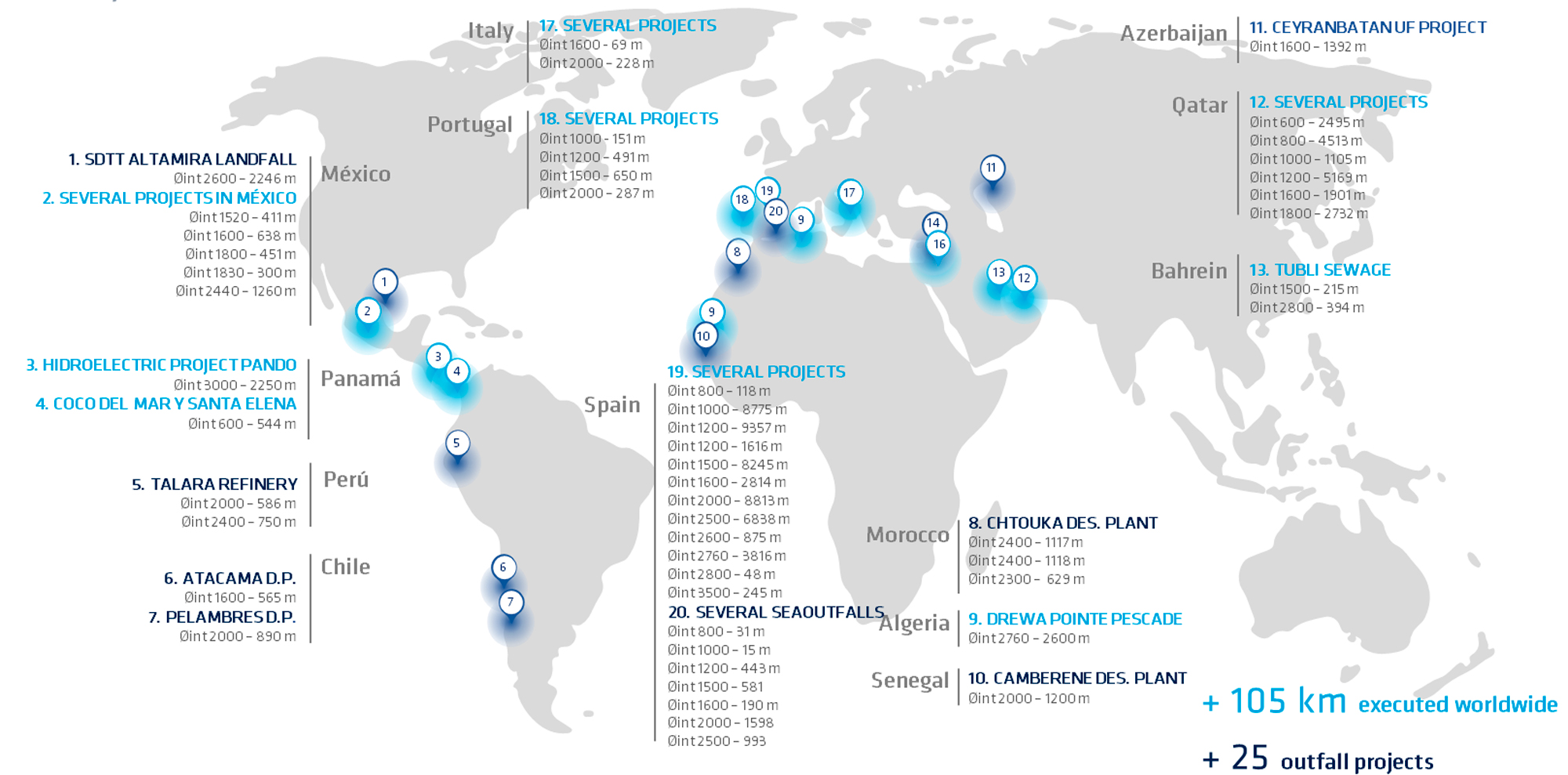Direct Pipe

Direct Pipe: The fast and efficient solution for pipe installation
The method Direct Pipe combina las mejores características de la microtúneladora y la perforación horizontal dirigida, permitiendo la instalación de tuberías sin zanja en una única operación continua.
Gracias a su tecnología de empuje y excavación simultánea, evita la construcción de una zanja de ataque o recepción, y permite instalar tramos largos con alta precisión, seguridad y menor impacto ambiental.
Esta técnica se utiliza en obras críticas como submarine emissaries o cruces de áreas marinas protegidas, donde otras tecnologías no pueden operar con eficiencia.
Conoce más sobre esta técnica innovadora en el sitio oficial de Herrenknecht AG – desarrollador líder de la tecnología Direct Pipe®.
Space requirements for the use of Direct Pipe
Aunque el método Direct Pipe® reduce considerablemente el espacio necesario en superficie, es importante planificar adecuadamente la zona de trabajo, el posicionamiento del lanzador and the zona de recepción de la tubería.
Gracias a su diseño compacto, permite instalar tuberías de gran longitud en terrenos sensibles, zonas portuarias o áreas protegidas. En EUROHINCA lo aplicamos especialmente en:
Obras de cruce en entornos costeros complejos
Su eficiencia operativa lo convierte en una solución cada vez más demandada en proyectos con restricciones ambientales o urbanas.

Especificaciones del servicio Direct Pipe®
El método Direct Pipe® combina una microtuneladora de frente cerrado con un sistema de empuje continuo que instala tubería de acero definitiva en un único proceso. Este servicio se define por los siguientes parámetros técnicos y condiciones de aplicación:
• Aplicaciones principales: Cruces subterráneos bajo ríos, carreteras, líneas ferroviarias, zonas ambientales sensibles y áreas donde no es viable abrir zanjas o emplear HDD por limitaciones de terreno, presión o trazado.
• Diámetro y tubería de instalación: Utiliza tubería de acero soldada a medida, que se instala de forma continua durante el empuje. El diámetro final depende del proyecto, las condiciones del trazado y los requerimientos hidráulicos o estructurales.
• Longitudes habituales del cruce: Tramos de varias decenas a varios cientos de metros, condicionados por la geotecnia, la alineación, el peso de la tubería y la capacidad del sistema de empuje.
• Condiciones de terreno compatibles: Suelos cohesivos y mixtos, así como terrenos saturados o con nivel freático elevado. El uso de cabezales presurizados permite mantener la estabilidad del frente en entornos complejos donde HDD puede resultar menos adecuado.
• Construction method: Excavación mediante una tuneladora de frente cerrado, guiada desde un pozo de ataque, mientras la tubería de acero avanza solidariamente gracias al empuje continuo. El proceso no requiere estaciones intermedias y reduce fases respecto al microtúnel convencional.
• Requisitos de obra civil: Pozo de ataque con espacio suficiente para alojar la tuneladora, el sistema de empuje y la línea de tubería prefabricada; además de accesos, planta de lodos, bombas y zonas de maniobra para la soldadura y manipulación de la conducción.
• Control del empuje y la alineación: Monitorización de los esfuerzos de empuje transmitidos a la tubería, control de la presión de cámara, guiado en tiempo real y verificación de la alineación según las tolerancias definidas para el proyecto.
• Fluidos y gestión del material excavado: Uso de lodos bentoníticos o polímeros para estabilizar el frente, transportar detrito y mantener la integridad del túnel. El circuito de retorno se gestiona mediante planta de lodos y sistemas de separación.
• Control de calidad y seguridad: Registro continuo de parámetros de excavación, supervisión del comportamiento de la tubería durante el empuje, verificación estructural final y cumplimiento de los protocolos de seguridad en pozos y zonas de soldadura.
Opiniones de clientes
Clientes institucionales, ingenierías y contratistas valoran la precisión y rapidez de nuestras ejecuciones con Direct Pipe en todo tipo de condiciones geológicas.
Projects around the world
EUROHINCA ha aplicado tecnología de hinca de tubería de hormigón armado con tuneladora de escudo cerrado en proyectos en América, Europa y África, incluyendo instalaciones críticas en zonas costeras y entornos con alto nivel freático. Consulta nuestros proyectos y obras ejecutadas.
Request for information
¿Tienes un trazado complicado o zona sensible?
Escríbenos y analizamos si la hinca de tubería es la solución más adecuada para tu proyecto.
¿Qué técnicas se emplean en la construcción de túneles sin zanja?
La técnica Direct Pipe se posiciona como una solución de vanguardia frente a otras como el microtúnel o la HDD, especialmente en obras donde la precisión, el tiempo y la accesibilidad son limitados.
Explora más artículos técnicos en nuestra sección de noticias

What techniques are used in tunnel construction?
Tunnel construction is a complex task that requires the application of various advanced techniques to ensure stability.
Frequently asked questions about direct pipe
¿Tienes más dudas? Visita nuestra sección completa de frequent questions para conocer más sobre nuestros servicios y tecnologías.
What is the Direct Pipe method and how does it differ from other pipe installation techniques?
The method Direct Pipe is an innovative technique that combines the advantages of microtunneling and horizontal directional drilling (HDD). Unlike other methods, Direct Pipe allows excavation and pipe installation to be performed simultaneously, eliminating the need for additional tunnel extensions and a reaction wall attack shaft. This makes it faster, more versatile and efficient, adapting to a wide range of ground conditions.
On what kind of soils can Direct Pipe be used?
Direct Pipe is applicable to almost any ground condition, from soft to rocky soils. Its versatility allows this method to be used in a variety of projects, including crossings under rivers, highways, and in densely populated urban areas. The method's ability to adapt to different soil types without losing efficiency is one of its main advantages.
What advantages does Direct Pipe offer compared to other pipe installation methods?
Direct Pipe offers several key advantages over other methods. By performing excavation and pipe installation simultaneously, project time is significantly reduced. In addition, it does not require tunnel enlargement or a reaction wall attack shaft, which simplifies logistics and reduces costs. It is also less invasive, minimizing environmental impact and disturbance in sensitive or urban areas.
What are the space requirements for implementing Direct Pipe?
One of the main requirements for implementing the Direct Pipe method is the need for a substantial ramp surface. This is because the process requires a long and stable working platform where the metallic pipe can be welded prior to installation. This spatial requirement can be a challenge in environments with limited space, such as urban areas, but is still feasible in projects with sufficient space available.
What types of pipes can be installed with the Direct Pipe method?
Direct Pipe is particularly suitable for the installation of large diameter pipes, usually metallic, which require a high degree of precision and control during installation. This method is ideal for pipelines used in the infrastructure for transporting water, gas, oil and other fluids through difficult terrain or environmentally sensitive areas.
What environmental considerations should be taken into account when using Direct Pipe?
The Direct Pipe method is less invasive than other traditional pipe installation methods, making it more environmentally friendly. By minimizing the need for open-cut excavation, the impact on the surface and surrounding vegetation is significantly reduced. In addition, its ability to work in difficult soils without significantly altering the environment makes it an ideal choice for projects in ecologically sensitive areas.
Solve your doubts in our section of frequent questions.


